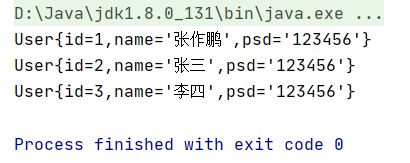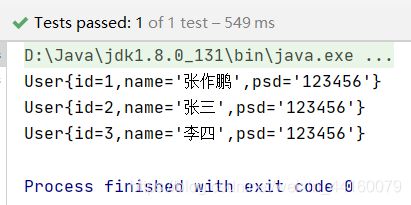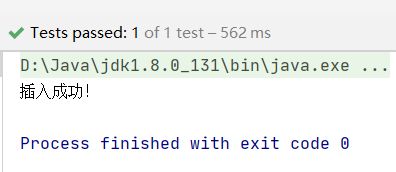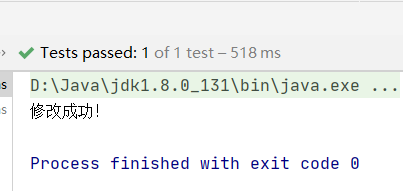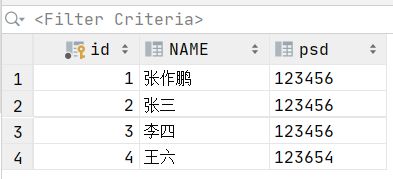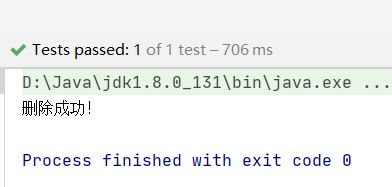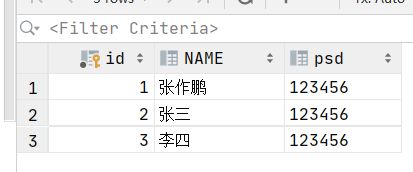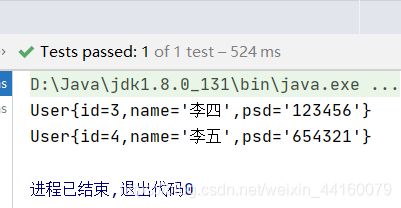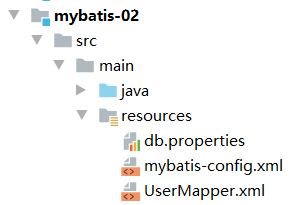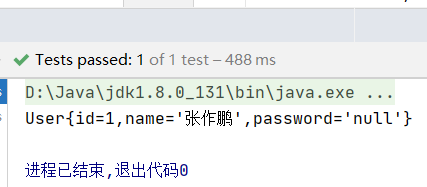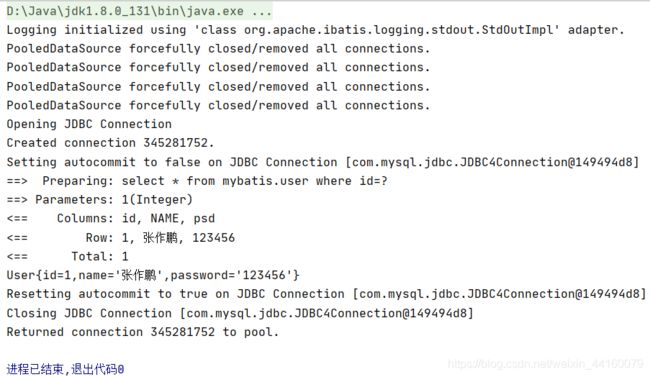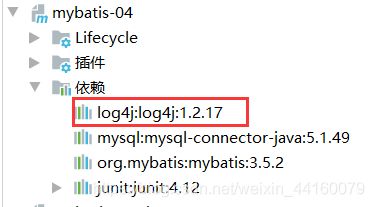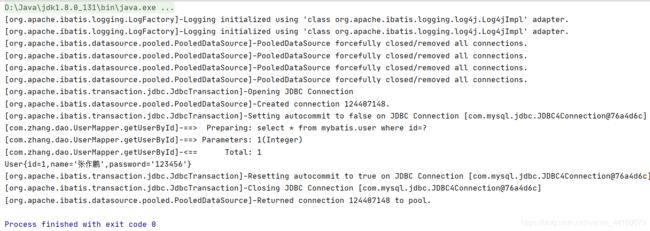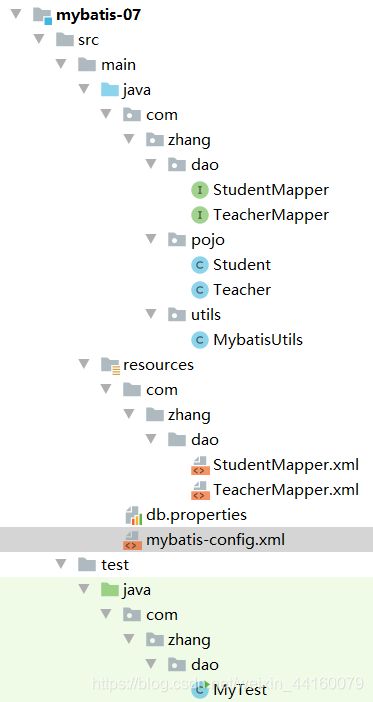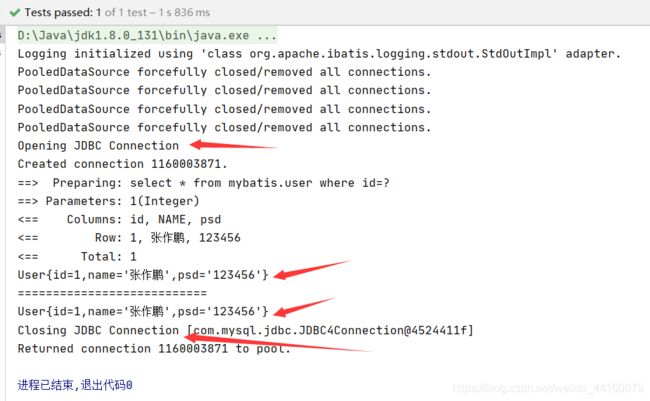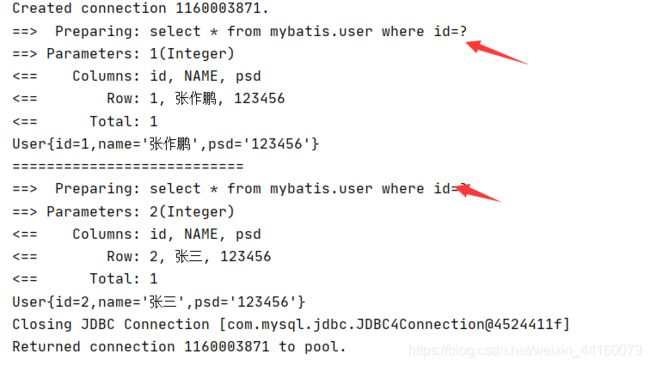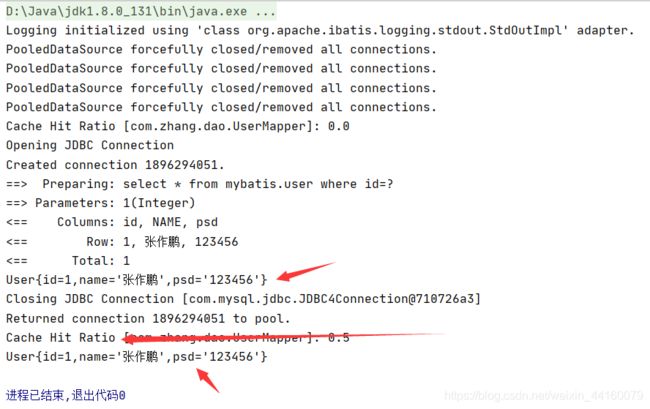MyBatis_Learning_大三课程预习
MyBatis_Learning_大三课程预习
- 1. 第一个Mybatis程序
-
- 1. 搭建环境
-
- 1.1 搭建数据库
- 1.2 新建项目
- 2. 创建一个模块
-
- 2.1 编写mybatis核心配置文件
- 2.2 编写mybatis工具类
- 3. 编写代码
-
- 3.1 实体类
- 3.2 Dao接口
- 3.3 接口实现类
- 4. 测试
- 5. 测试效果
- 2. CRUD
-
- 1. namespace
- 2. select
-
- 2.1 编写接口
- 2.2 编写对应的sql中的语句
- 2.3 测试
- 3. insert
- 4. update
- 5. delete
- 6. 模糊查询实现(like)
-
- 6.1 编写接口
- 6.2 编写对应的sql中的语句
- 6.3 测试
- 3. 配置解析
-
- 1. 核心配置文件
- 2. 环境配置(environments)
-
- 2.1 事务管理器(transactionManager)
- 2.2 数据源(dataSource)
- 3. 属性(properties)
- 4. 映射器(mappers)
- 5. 作用域(Scope)和生命周期
- 4. 解决属性名和字段名不一致的问题(ResultMap)
-
- 1. 问题出现
- 2. resultMap结果集映射
- 5. 日志
-
- 1. 日志工厂
- 2. LOG4J
-
- 2.1 配置log4j
- 2.2 使用log4j
- 6. 使用注解开发
-
- 1. 使用注解开发
- 2. MyBatis详细执行流程
- 3. CRUD
- 7. 多对一与一对多
-
- 1. 复杂查询环境搭建
-
- 1.1 表建立
- 1.2 新建实体类Teacher,Student
- 1.3 建立Mapper接口
- 1.4 建立Mapper.xml文件
- 1.5 在核心配置文件中注册绑定Mapper.xml
- 1.6 文件结构一览
- 1.7 测试
- 2. 多对一处理
-
- 2.1 按照查询嵌套处理
- 2.2 按照结果嵌套处理
- 3. 一对多
-
- 3.1 修改实体类
- 3.2 按照结果嵌套处理
- 3.3 按照查询嵌套处理
- 4. 小结
- 8. 动态SQL
-
- 1. 描述
- 2. 搭建环境
-
- 2.1创建数据库
- 2.2创建基础工程
- 3. if
- 4. choose、when、otherwise
- 5. trim、where、set
- 6. SQL片段
- 7. foreach
- 8. 小结
- 9. 缓存
-
- 1. 简介
- 2. MyBatis缓存
- 3. 一级缓存
-
- 3.1 概述
- 3.2 步骤
- 4. 二级缓存
-
- 4.1 概述
- 4.2 步骤
1. 第一个Mybatis程序
1. 搭建环境
1.1 搭建数据库
CREATE DATABASE `mybatis`;
USE `mybatis`;
CREATE TABLE `user` (
`id` INT ( 20 ) NOT NULL PRIMARY KEY,
`NAME` VARCHAR ( 20 ) DEFAULT NULL,
`psd` VARCHAR ( 20 ) DEFAULT NULL
) ENGINE = INNODB DEFAULT CHARSET = utf8;
INSERT INTO `user` ( `id`, `name`, `psd` ) VALUES
( 1, '张作鹏', '123456' ),
( 2, '张三', '123456' ),
( 3, '李四', '123456' )
1.2 新建项目
1.新建一个普通maven项目
2.删除src目录(建立父工程)
3.导入maven依赖
pom.xml(父工程中)
<project xmlns="http://maven.apache.org/POM/4.0.0"
xmlns:xsi="http://www.w3.org/2001/XMLSchema-instance"
xsi:schemaLocation="http://maven.apache.org/POM/4.0.0 http://maven.apache.org/xsd/maven-4.0.0.xsd">
<modelVersion>4.0.0modelVersion>
<groupId>com.zhanggroupId>
<artifactId>Mybatis-StudyartifactId>
<packaging>pompackaging>
<version>1.0-SNAPSHOTversion>
<modules>
<module>mybatis-01module>
modules>
<dependencies>
<dependency>
<groupId>mysqlgroupId>
<artifactId>mysql-connector-javaartifactId>
<version>5.1.49version>
dependency>
<dependency>
<groupId>org.mybatisgroupId>
<artifactId>mybatisartifactId>
<version>3.5.2version>
dependency>
<dependency>
<groupId>junitgroupId>
<artifactId>junitartifactId>
<version>4.12version>
dependency>
dependencies>
<build>
<resources>
<resource>
<directory>src/main/resourcesdirectory>
<includes>
<include>**/*.propertiesinclude>
<include>**/*.xmlinclude>
includes>
<filtering>truefiltering>
resource>
<resource>
<directory>src/main/javadirectory>
<includes>
<include>**/*.propertiesinclude>
<include>**/*.xmlinclude>
includes>
<filtering>truefiltering>
resource>
resources>
build>
project>
2. 创建一个模块
2.1 编写mybatis核心配置文件
mybatis-config.xml
<configuration>
<environments default="development">
<environment id="development">
<transactionManager type="JDBC"/>
<dataSource type="POOLED">
<property name="driver" value="com.mysql.jdbc.Driver"/>
<property name="url" value="jdbc:mysql://localhost:3306/mybatis?useSSL=false&useUnicode=true&characterEncoding=UTF8"/>
<property name="username" value="root"/>
<property name="password" value="123456"/>
dataSource>
environment>
environments>
<mappers>
<mapper resource="UserMapper.xml"/>
mappers>
configuration>
2.2 编写mybatis工具类
MybatisUtils.java
package com.zhang.utils;
import org.apache.ibatis.io.Resources;
import org.apache.ibatis.session.SqlSession;
import org.apache.ibatis.session.SqlSessionFactory;
import org.apache.ibatis.session.SqlSessionFactoryBuilder;
import java.io.IOException;
import java.io.InputStream;
//sqlSessionFactory --> sqlSession
public class MybatisUtils {
private static SqlSessionFactory sqlSessionFactory;
static{
try{
//使用Mybatis第一步:获取sqlSessionFactory对象
String resource = "mybatis-config.xml";
InputStream inputStream = Resources.getResourceAsStream(resource);
sqlSessionFactory = new SqlSessionFactoryBuilder().build(inputStream);
}catch (IOException e){
e.printStackTrace();
}
}
//既然有了 SqlSessionFactory,顾名思义,我们可以从中获得 SqlSession 的实例。
//SqlSession 提供了在数据库执行 SQL 命令所需的所有方法。
//你可以通过 SqlSession 实例来直接执行已映射的 SQL 语句。
public static SqlSession getSqlSession(){
return sqlSessionFactory.openSession();
}
}
3. 编写代码
3.1 实体类
User.java
package com.zhang.pojo;
//实体类
public class User {
private int id;
private String name;
private String psd;
public User(){
}
public User(int id, String name, String psd){
this.id = id;
this.name = name;
this.psd = psd;
}
public int getId(){ return id; }
public void setId(int id){ this.id = id; }
public String getName(){ return name; }
public void setName(String name){ this.name = name; }
public String getPsd(){ return psd; }
public void setPsd(String psd){ this.psd = psd; }
@Override
public String toString(){
return "User{" +
"id=" + id +
",name='" + name + '\'' +
",psd='" + psd + '\'' +
"}";
}
}
3.2 Dao接口
UserDao.java
package com.zhang.dao;
import com.zhang.pojo.User;
import java.util.List;
public interface UserDao {
List<User> getUserList();
}
3.3 接口实现类
(由原来的UserDaolmpl转变为一个Mapper配置文件)
UserMapper.xml
<mapper namespace="com.zhang.dao.UserDao">
<select id="getUserList" resultType="com.zhang.pojo.User">
select * from mybatis.user
select>
mapper>
4. 测试
注意点:org.apache.ibatis.binding.BindingException: Type interface com.zhang.dao.UserDao is not known to the MapperRegistry.
junit测试
UserDaoTest.java
package com.zhang.dao;
import com.zhang.pojo.User;
import com.zhang.utils.MybatisUtils;
import org.apache.ibatis.session.SqlSession;
import org.junit.Test;
import java.util.List;
public class UserDaoTest {
@Test
public void test(){
//第一步:获得SqlSession对象
SqlSession sqlSession = MybatisUtils.getSqlSession();
try {
//方式一:getMapper
UserDao userDao = sqlSession.getMapper(UserDao.class);
List<User> userList = userDao.getUserList();
//方式二
//List userList = sqlSession.selectList("com.zhang.dao.UserDao.getUserList");
for (User user : userList){
System.out.println(user);
}
}catch (Exception e){
e.printStackTrace();
}finally {
//关闭SqlSession
sqlSession.close();
}
}
}
5. 测试效果
建立好的目录一览
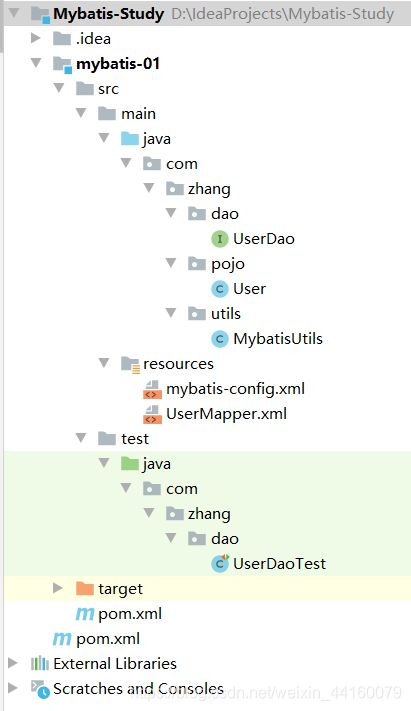
PS:菜死了我,写了一天,发现是目录写错了,还有一个地方写错了一个字母,报错不停,教学视频看了三次,第一次预习,第二次跟着写代码,第三次查错误,终于晚上十一点搞出来了结果,路漫漫其修远兮。
2. CRUD
CRUD是指:增加(Create)、检索(Retrieve)、更新(Update)和删除(Delete)
即:增删改查
1. namespace
namespace中的包名要和Dao/Mapper接口的包名一致。
2. select
id:就是对应的namespace中的方法名;
resultTpye:sql语句执行的返回值;
parameterType:参数类型。
2.1 编写接口
//根据id查询用户
User getUserById(int id);
2.2 编写对应的sql中的语句
<select id="getUserById" parameterType="int" resultType="com.zhang.pojo.User">
select * from mybatis.user where id=#{id}
select>
2.3 测试
@Test
public void getUserById(){
SqlSession sqlSession = MybatisUtils.getSqlSession();
UserMapper userMapper = sqlSession.getMapper(UserMapper.class);
User user = userMapper.getUserById(1);
System.out.println(user);
sqlSession.close();
}
3. insert
<insert id="addUser" parameterType="com.zhang.pojo.User">
insert into mybatis.user (id, name, psd) value (#{id},#{name},#{psd});
insert>
4. update
<update id="updateUser" parameterType="com.zhang.pojo.User">
update mybatis.user set name=#{name}, psd=#{psd} where id=#{id};
update>
5. delete
<delete id="deleteUser" parameterType="com.zhang.pojo.User">
delete from mybatis.user where id=#{id}
delete>
6. 模糊查询实现(like)
6.1 编写接口
//模糊查询
List<User> getUserLike(String value);
6.2 编写对应的sql中的语句
<select id="getUserLike" resultType="com.zhang.pojo.User">
select * from mybatis.user where name like #{value}
select>
6.3 测试
@Test
public void getUserLike(){
SqlSession sqlSession = MybatisUtils.getSqlSession();
UserMapper userMapper = sqlSession.getMapper(UserMapper.class);
List<User> userList = userMapper.getUserLike("%李%");
for (User user : userList){
System.out.println(user);
}
sqlSession.close();
}
- Java代码执行的时候,传递通配符% %
List<User> userList = userMapper.getUserLike("%李%");
- 在SQL拼接中使用通配符
select * from mybatis.user where name like "%"#{value}"%"
3. 配置解析
1. 核心配置文件
mybatis-config.xml
MyBatis的配置文件包含了会深深影响MyBatis行为的设置和属性信息
configuration(配置)
properties(属性)
settings(设置)
typeAliases(类型别名)
typeHandlers(类型处理器)
objectFactory(对象工厂)
plugins(插件)
environments(环境配置)
environment(环境变量)
transactionManager(事务管理器)
dataSource(数据源)
databaseIdProvider(数据库厂商标识)
mappers(映射器)
2. 环境配置(environments)
-
MyBatis 可以配置成适应多种环境 尽
-
管可以配置多个环境,但每个 SqlSessionFactory 实例只能选择一种环境
2.1 事务管理器(transactionManager)
有两个值,JDBC和MANAGED
MyBatis使用JDBC
<transactionManager type="JDBC"/>
2.2 数据源(dataSource)
有三个值,UNPOOLED、POOLED和JNDI
MyBatis使用POOLED
<dataSource type="POOLED">
······
dataSource>
3. 属性(properties)
我们可以通过properties属性来实现引用配置文件
这些属性可以在外部进行配置,并可以进行动态替换。你既可以在典型的 Java 属性文件中配置这些属性,也可以在 properties 元素的子元素中设置。
db.properties
driver=com.mysql.jdbc.Driver
url=jdbc:mysql://localhost:3306/mybatis?useSSL=false&useUnicode=true&characterEncoding=UTF8
username=root
password=123456
mybatis-config.xml
<properties resource="db.properties" />
4. 映射器(mappers)
<mappers>
<mapper resource="UserMapper.xml"/>
mappers>
5. 作用域(Scope)和生命周期
理解我们之前讨论过的不同作用域和生命周期类别是至关重要的,因为错误的使用会导致非常严重的并发问题。
SqlSessionFactoryBuilder
- 一旦创建了SqlSessionFactory,就不再需要它了;
- 局部变量;
- 因此 SqlSessionFactoryBuilder 实例的最佳作用域是方法作用域(也就是局部方法变量)。
SqlSessionFactory
- 说白了就可以想象为:DBCP;
- SqlSessionFactory 一旦被创建就应该在应用的运行期间一直存在,没有任何理由丢弃它或重新创建另一个实例;
- 因此 SqlSessionFactory 的最佳作用域是应用作用域;
- 最简单的就是使用单例模式或者静态单例模式。
SqlSession
- 连接到连接池的一个请求;
- 它的最佳的作用域是请求或方法作用域;
- 用完之后应当关闭,否则资源会被占用;
4. 解决属性名和字段名不一致的问题(ResultMap)
1. 问题出现
private int id;
private String name;
private String password;
- 起别名
select id,name,psd as password from mybatis.user where id=#{id}
2. resultMap结果集映射
<resultMap id="UserMap" type="com.zhang.pojo.User">
<result column="psd" property="password"/>
resultMap>
<select id="getUserById" resultMap="UserMap">
select * from mybatis.user where id=#{id}
select>
- resultMap 元素是 MyBatis 中最重要最强大的元素;
- ResultMap 的设计思想是,对简单的语句做到零配置,对于复杂一点的语句,只需要描述语句之间的关系就行了;
- 这就是 ResultMap 的优秀之处——你完全可以不用显式地配置它们。
5. 日志
1. 日志工厂
如果一个数据库操作,出现了异常,我们需要排错,日志就是最好的助手!
曾经:sout、debug
现在:日志工厂

- SLF4J
- LOG4J(掌握)
- LOG4J2
- JDK_LOGGING
- COMMONS_LOGGING
- STDOUT_LOGGING(掌握)
- NO_LOGGING
在MyBatis中具体使用哪一个日志实现,在设置中设定。
<settings>
<setting name="logImpl" value="STDOUT_LOGGING"/>
settings>
2. LOG4J
何为log4j?
- Log4j是Apache的一个开源项目,通过使用Log4j,我们可以控制日志信息输送的目的地是控制台、文件、GUI组件;
- 我们也可以控制每一条日志的输出格式;
- 通过定义每一条日志信息的级别,我们能够更加细致地控制日志的生成过程;
- 可以通过一个配置文件来灵活地进行配置,而不需要修改应用的代码。
2.1 配置log4j
- 导入log4j的包
<dependency>
<groupId>log4jgroupId>
<artifactId>log4jartifactId>
<version>1.2.17version>
dependency>
- log4j.properties
#将等级为DEBUG的日志信息输出到console和file这两个目的地,console和file的定义在下面的代码
log4j.rootLogger=DEBUG,console,file
#控制台输出的相关设置
log4j.appender.console = org.apache.log4j.ConsoleAppender
log4j.appender.console.Target = System.out
log4j.appender.console.Threshold=DEBUG
log4j.appender.console.layout = org.apache.log4j.PatternLayout
log4j.appender.console.layout.ConversionPattern=[%c]-%m%n
#文件输出的相关设置
log4j.appender.file = org.apache.log4j.RollingFileAppender
log4j.appender.file.File=./log/zhang.log
log4j.appender.file.MaxFileSize=10mb
log4j.appender.file.Threshold=DEBUG
log4j.appender.file.layout=org.apache.log4j.PatternLayout
log4j.appender.file.layout.ConversionPattern=[%p][%d{yy-MM-dd}][%c]%m%n
#日志输出级别
log4j.logger.org.mybatis=DEBUG
log4j.logger.java.sql=DEBUG
log4j.logger.java.sql.Statement=DEBUG
log4j.logger.java.sql.ResultSet=DEBUG
log4j.logger.java.sql.PreparedStatement=DEBUG
- 配置log4j为日志的实现
<settings>
<setting name="logImpl" value="LOG4J"/>
settings>
2.2 使用log4j
- 在要使用log4j的类中,导入包
import org.apache.log4j.Logger;
- 日志对象,参数为当前类的class
static Logger logger = Logger.getLogger(UserDaoTest.class);
- 日志级别
@Test
public void testLog4j(){
logger.info("info:进入了testLog4j");
logger.debug("debug:进入了testLog4j");
logger.error("error:进入了testLog4j");
}
6. 使用注解开发
1. 使用注解开发
- 注解在接口上实现
@Select("select * from user")
List<User> getUsers();
- 需要在核心配置文件上绑定接口
<mappers>
<mapper class="com.zhang.dao.UserMapper"/>
mappers>
- 测试
本质:反射机制实现
底层:动态代理
2. MyBatis详细执行流程
3. CRUD
- 可以在工具类创建的时候就设置自动提交事务。
public static SqlSession getSqlSession(){
return sqlSessionFactory.openSession(true);
}
- 编写接口,增加注解
- 测试
注意:必须将接口类注册到核心配置文件中
7. 多对一与一对多
1. 复杂查询环境搭建
1.1 表建立
CREATE TABLE `teacher` (
`id` INT(10) NOT NULL,
`name` VARCHAR(30) DEFAULT NULL,
PRIMARY KEY (`id`)
) ENGINE=INNODB DEFAULT CHARSET=utf8
INSERT INTO teacher(`id`, `name`) VALUES (1, '张老师');
CREATE TABLE `student` (
`id` INT(10) NOT NULL,
`name` VARCHAR(30) DEFAULT NULL,
`tid` INT(10) DEFAULT NULL,
PRIMARY KEY (`id`),
KEY `fktid` (`tid`),
CONSTRAINT `fktid` FOREIGN KEY (`tid`) REFERENCES `teacher` (`id`)
) ENGINE=INNODB DEFAULT CHARSET=utf8
INSERT INTO `student` (`id`, `name`, `tid`) VALUES ('1', '小明', '1');
INSERT INTO `student` (`id`, `name`, `tid`) VALUES ('2', '小红', '1');
INSERT INTO `student` (`id`, `name`, `tid`) VALUES ('3', '小张', '1');
INSERT INTO `student` (`id`, `name`, `tid`) VALUES ('4', '小李', '1');
INSERT INTO `student` (`id`, `name`, `tid`) VALUES ('5', '小王', '1');
1.2 新建实体类Teacher,Student
Teacher.java(部分代码)
package com.zhang.pojo;
public class Teacher {
private int id;
private String name;
}
Student.java(部分代码)
package com.zhang.pojo;
public class Student {
private int id;
private String name;
private Teacher teacher;
}
1.3 建立Mapper接口
StudentMapper.java(略)
TeacherMapper.java(部分代码)
@Select("select * from teacher where id=#{tid}")
Teacher getTeacher(@Param("tid") int id);
1.4 建立Mapper.xml文件
1.5 在核心配置文件中注册绑定Mapper.xml
<mappers>
<mapper resource="com/zhang/dao/StudentMapper.xml"/>
<mapper resource="com/zhang/dao/TeacherMapper.xml"/>
mappers>
1.6 文件结构一览
1.7 测试
2. 多对一处理
此时,我们要根据学生查出老师,即:在输出学生信息时,输出老师的信息
2.1 按照查询嵌套处理
<select id="getStudent" resultMap="StudentTeacher">
select * from student;
select>
<resultMap id="StudentTeacher" type="com.zhang.pojo.Student">
<id property="id" column="id"/>
<id property="name" column="name"/>
<association property="teacher" column="tid" javaType="com.zhang.pojo.Teacher" select="getTeacher"/>
resultMap>
<select id="getTeacher" resultType="com.zhang.pojo.Teacher">
select * from teacher where id=#{id};
select>
2.2 按照结果嵌套处理
<select id="getStudent2" resultMap="StudentTeacher2">
select s.id sid,s.name sname,t.name tname,t.id tid
from student s,teacher t
where s.tid=t.id;
select>
<resultMap id="StudentTeacher2" type="com.zhang.pojo.Student">
<result property="id" column="sid"/>
<result property="name" column="sname"/>
<association property="teacher" javaType="com.zhang.pojo.Teacher">
<result property="name" column="tname"/>
<result property="id" column="tid"/>
association>
resultMap>
3. 一对多
此时,我们要根据老师查询学生,即:在输出老师信息时,输出学生的信息
3.1 修改实体类
Teacher.java(部分代码)
package com.zhang.pojo;
public class Teacher {
private int id;
private String name;
private List<Student> studentList;
}
Student.java(部分代码)
package com.zhang.pojo;
public class Student {
private int id;
private String name;
private int sid;
}
3.2 按照结果嵌套处理
<select id="getTeacher" resultMap="TeacherStudent">
select s.id sid,s.name sname,t.name tname,t.id tid
from student s,teacher t
where s.tid=t.id and t.id=#{tid}
select>
<resultMap id="TeacherStudent" type="com.zhang.pojo.Teacher">
<result property="id" column="tid"/>
<result property="name" column="tname"/>
<collection property="studentList" ofType="com.zhang.pojo.Student">
<result property="id" column="sid"/>
<result property="name" column="sname"/>
<result property="tid" column="tid"/>
collection>
resultMap>
3.3 按照查询嵌套处理
<select id="getTeacher2" resultMap="TeacherStudent2">
select * from teacher where id=#{tid}
select>
<resultMap id="TeacherStudent2" type="com.zhang.pojo.Teacher">
<collection property="studentList" javaType="ArrayList" ofType="com.zhang.pojo.Student" select="getStudentByTeacherId" column="id"/>
resultMap>
<select id="getStudentByTeacherId" resultType="com.zhang.pojo.Student">
select * from student where tid=#{tid}
select>
4. 小结
- 对象:associatioon
- 集合:collection
- javaTpye & ofType
- javaTpye 用来指定实体类中属性的类型
- ofType 用来指定映射到List或者集合中的pojo类型,泛型中的约束类型
- MySql引擎
- InnoDB底层原理
- 索引
- 索引优化
8. 动态SQL
1. 描述
官方描述
动态 SQL 是 MyBatis 的强大特性之一。如果你使用过 JDBC 或其它类似的框架,你应该能理解根据不同条件拼接 SQL 语句有多痛苦,例如拼接时要确保不能忘记添加必要的空格,还要注意去掉列表最后一个列名的逗号。利用动态 SQL,可以彻底摆脱这种痛苦。
简言之
动态 SQL就是根据不同的条件生成不同的SQL语句。
2. 搭建环境
2.1创建数据库
CREATE TABLE `blog`(
`id` VARCHAR(50) NOT NULL COMMENT '博客id',
`title` VARCHAR(100) NOT NULL COMMENT '博客标题',
`author` VARCHAR(30) NOT NULL COMMENT '博客作者',
`create_time` DATETIME NOT NULL COMMENT '创建时间',
`views` INT(30) NOT NULL COMMENT '浏览量'
)ENGINE=INNODB DEFAULT CHARSET=utf8
2.2创建基础工程
- 导包
- 编写配置文件
- 编写实体类
package com.zhang.pojo;
public class Blog {
private int id;
private String title;
private String author;
private String createTime;
private int views;
public void setId(int id) {
this.id = id;
}
public int getId() {
return id;
}
public void setTitle(String title) {
this.title = title;
}
public String getTitle() {
return title;
}
public String getAuthor() {
return author;
}
public void setAuthor(String author) {
this.author = author;
}
public String getCreateTime() {
return createTime;
}
public void setCreateTime(String createTime) {
this.createTime = createTime;
}
public int getViews() {
return views;
}
public void setViews(int views) {
this.views = views;
}
}
- 编写实体类对应的Mapper接口以及Mapper.xml文件
3. if
select * from mybatis.blog where 1=1
<if test="title != null">
and title=#{title}
if>
<if test="author != null">
and author=#{author}
if>
4. choose、when、otherwise
select * from mybatis.blog
<where>
<choose>
<when test="title != null">
title=#{title}
when>
<when test="author != null">
and author=#{author}
when>
<otherwise>
and views=#{views}
otherwise>
choose>
where>
5. trim、where、set
where 元素只会在子元素返回任何内容的情况下才插入 “WHERE” 子句。
而且,若子句的开头为 “AND” 或 “OR”,where 元素也会将它们去除。
where
select * from mybatis.blog
<where>
<if test="title != null">
title=#{title}
if>
<if test="author != null">
and author=#{author}
if>
where>
set
update mybatis.blog
<set>
<if test="title!=null">
title=#{title},
if>
<if test="author!=null">
author=#{author}
if>
set>
where id=#{id}
6. SQL片段
有时候,我们将部分sql语句抽出来,方便复用
<sql id="if-title-author">
<if test="title != null">
title=#{title}
if>
<if test="author != null">
and author=#{author}
if>
sql>
<select id="queryBlogIF" parameterType="map" resultType="com.zhang.pojo.Blog">
select * from mybatis.blog
<where>
<include refid="if-title-author"/>
where>
select>
- 最好基于单表
- 不要封装where标签
7. foreach
动态 SQL 的另一个常见使用场景是对集合进行遍历(尤其是在构建 IN 条件语句的时候)
<select id="queryBlogForeach" parameterType="map" resultType="com.zhang.pojo.Blog">
select * from mybatis.blog
<where>
<foreach collection="ids" item="id" open="and (" close=")" separator=" or ">
id=#{id}
foreach>
where>
select>
@Test
public void queryBlogForeach(){
SqlSession sqlSession = MybatisUtils.getSqlSession();
BlogMapper mapper = sqlSession.getMapper(BlogMapper.class);
HashMap map = new HashMap();
ArrayList<Integer> ids = new ArrayList<Integer>();
map.put("ids",ids);
ids.add(1);
ids.add(2);
ids.add(3);
List<Blog> blogs = mapper.queryBlogForeach(map);
for (Blog blog : blogs) {
System.out.println(blog);
}
sqlSession.close();
}
8. 小结
动态SQL就是在拼接SQL语句,我们只要保证SQL的正确性,按照SQL的格式,去排列组合就可以了。
建议:
- 在MySql中写出对应的sql,再对应修改为动态sql
9. 缓存
1. 简介
一次查询的结果,给他暂存在一个可以直接取到的地方!内存–>缓存
再次查询相同数据时,直接走缓存,就不查询数据库了
1.什么是缓存[ Cache ]?
- 存在内存中的临时数据。
- 将用户经常查询的数据放在缓存(内存)中,用户去查询数据就不用从磁盘上(关系型数据库数据文件)查询,从缓存中查询,从而提高查询效率,解决了高并发系统的性能问题。
2.为什么使用缓存? - 减少和数据库的交互次数,减少系统开销,提高系统效率。
3.什么样的数据能使用缓存? - 经常查询并且不经常改变的数据。
2. MyBatis缓存
MyBatis包含一个非常强大的查询缓存特性, 它可以非常方便地定制和配置缓存。缓存可以极大的提升查询效率。
MyBatis系统中默认定义了两级缓存:一级缓存和二级缓存
- 默认情况下,只有一 -级缓存开启。 (SqlSession级别的缓存, 也称为本地缓存)
- 二级缓存需要手动开启和配置,他是基于namespace级别的缓存。
- 为了提高扩展性,MyBatis定义了缓存接口Cache,我们可以通过实现Cache接口来实现二级缓存。
3. 一级缓存
3.1 概述
一级缓存也叫本地缓存:
- 与数据库同一次会话期间查询到的数据会放在本地缓存中。
- 以后如果需要获取相同的数据,直接从缓存中拿,没必须再去查询数据库。
3.2 步骤
- 开启日志
- 测试在一个session中查询两次记录
@Test
public void test(){
SqlSession sqlSession = MybatisUtils.getSqlSession();
UserMapper mapper = sqlSession.getMapper(UserMapper.class);
User user = mapper.queryUserById(1);
System.out.println(user);
System.out.println("===========================");
User user2 = mapper.queryUserById(1);
System.out.println(user2);
sqlSession.close();
}
观察可得出,查询相同用户,sql语句只执行了一次,查询两个用户,sql语句执行了两次。
缓存失效情况:
- 增删改操作可能会改变原来的数据,会刷新缓存;
- 查询不同的东西
- 手动请理缓存
sqlSession.clearCache();
- 查询不同的Mapper.xml
4. 二级缓存
4.1 概述
- 二级缓存也叫全局缓存, 一级缓存作用域太低了,所以诞生了二级缓存
- 基于namespace级别的缓存,一个名称空间,对应一个二级缓存;
- 工作机制
- 一个会话查询一条数据,这个数据就会被放在当前会话的一-级缓存中;
- 如果当前会话关闭了,这个会话对应的一级缓存就没了:但是我们想要的是,会话关闭了,一级缓存中的数据被保存到二级缓存中;
- 新的会话查询信息,就可以从二级缓存中获取内容;
- 不同的mapper查出的数据会放在自己对应的缓存(map)中;
4.2 步骤
- 开启全局缓存
<settings>
<setting name="logImpl" value="STDOUT_LOGGING"/>
<setting name="cacheEnabled" value="true"/>
settings>
- 在要使用全局缓存的mapper中开启
<cache/>
或
<cache
eviction="FIFO"
flushInterval="60000"
size="512"
readOnly="true"/>
- 测试
@Test
public void test(){
SqlSession sqlSession = MybatisUtils.getSqlSession();
SqlSession sqlSession2 = MybatisUtils.getSqlSession();
UserMapper mapper = sqlSession.getMapper(UserMapper.class);
User user = mapper.queryUserById(1);
System.out.println(user);
sqlSession.close();
UserMapper mapper2 = sqlSession2.getMapper(UserMapper.class);
User user2 = mapper2.queryUserById(1);
System.out.println(user2);
sqlSession2.close();
}
